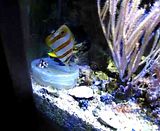Dr Colliebreath
New member
[Quote
So, my first question is about point of origin. CBB's are available from Indonesia, Singapore, Philippines, Solomon Islands and Australia (perhaps other places as well)...are some origins considered superior to others? I've read in the thread that Australian CBB's may be more hardy...thoughts/experience? Are some origins to be avoided?
Second, is there an ideal size for addition of a CBB to the captive environment? Bigger means more mature and while the intuitive thing is to assume they're more hardy, for some species the adults actually don't make the transition to captivity as well as younger fish. And in some cases the really little ones can't handle the stress. What's considered the "ideal" acquisition/introduction size for CBB's?
Finally, tankmates... I've seen numerous posts expressing concern over Yellow Tangs unless you have a "large" tank. Is 225g large enough? My Yellow Tang is medium
Following is the current plan for tankmates and the order in which they will be introduced. Anyone see any issues for the CBB in the list / introduction plan? Any fish missing from the list that you'd recommend?
You input is much appreciated...thank you.[/QUOTE]
I would get a 3-3.5" Australian cbb. Skip any from Indo or the Philippines.
Your proposed tankmates should be fine, including the yellow tang. Cbbs aren't aggressive eaters so be prepared to feed what it likes heavily, including particularly live blackworms, clam, and chopped seafood (scallop, shrimp and fish). I feed the other fish something the cbb won't eat first (NLS pellets and Omega One veggie flakes) and then put some food that the cbb will eat in the tank, let the cbb eat, then put more in, let the cbb eat, etc. I am going to put a feeding station in with holes that only the cbb can access.
The problem is that the cbb (and yln also) doesn't cruise the tank snapping up as many scraps of food as it can get, so you need to make sure it gets enough to eat. It will just get out-competed for food if you just dump food in and let the fish fend for themselves. This is just a fact of their nature in the wild, where they pick at pods, etc. on rocks rather than stuffing themselves when food is available.
So, my first question is about point of origin. CBB's are available from Indonesia, Singapore, Philippines, Solomon Islands and Australia (perhaps other places as well)...are some origins considered superior to others? I've read in the thread that Australian CBB's may be more hardy...thoughts/experience? Are some origins to be avoided?
Second, is there an ideal size for addition of a CBB to the captive environment? Bigger means more mature and while the intuitive thing is to assume they're more hardy, for some species the adults actually don't make the transition to captivity as well as younger fish. And in some cases the really little ones can't handle the stress. What's considered the "ideal" acquisition/introduction size for CBB's?
Finally, tankmates... I've seen numerous posts expressing concern over Yellow Tangs unless you have a "large" tank. Is 225g large enough? My Yellow Tang is medium
Following is the current plan for tankmates and the order in which they will be introduced. Anyone see any issues for the CBB in the list / introduction plan? Any fish missing from the list that you'd recommend?
You input is much appreciated...thank you.[/QUOTE]
I would get a 3-3.5" Australian cbb. Skip any from Indo or the Philippines.
Your proposed tankmates should be fine, including the yellow tang. Cbbs aren't aggressive eaters so be prepared to feed what it likes heavily, including particularly live blackworms, clam, and chopped seafood (scallop, shrimp and fish). I feed the other fish something the cbb won't eat first (NLS pellets and Omega One veggie flakes) and then put some food that the cbb will eat in the tank, let the cbb eat, then put more in, let the cbb eat, etc. I am going to put a feeding station in with holes that only the cbb can access.
The problem is that the cbb (and yln also) doesn't cruise the tank snapping up as many scraps of food as it can get, so you need to make sure it gets enough to eat. It will just get out-competed for food if you just dump food in and let the fish fend for themselves. This is just a fact of their nature in the wild, where they pick at pods, etc. on rocks rather than stuffing themselves when food is available.

